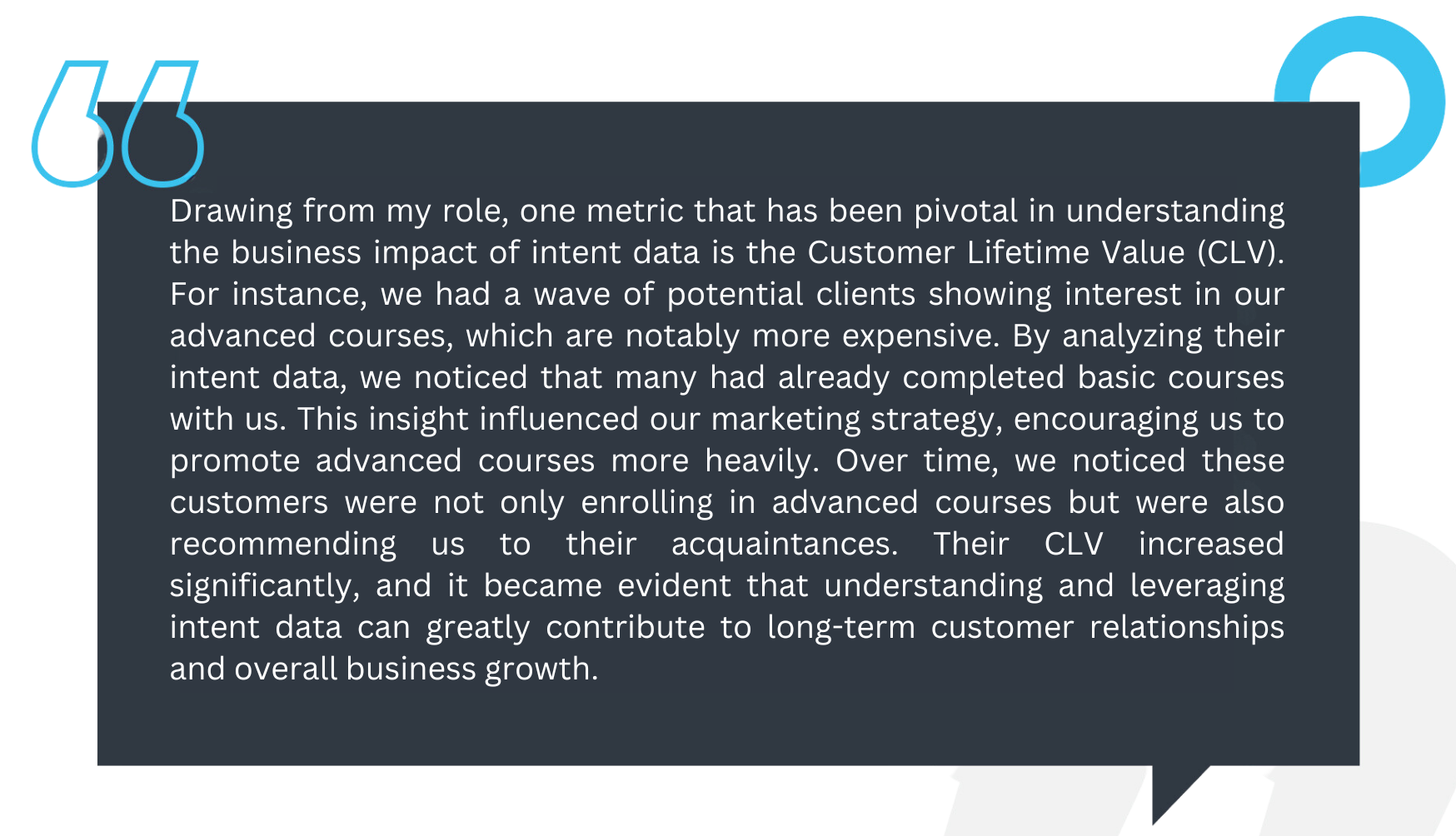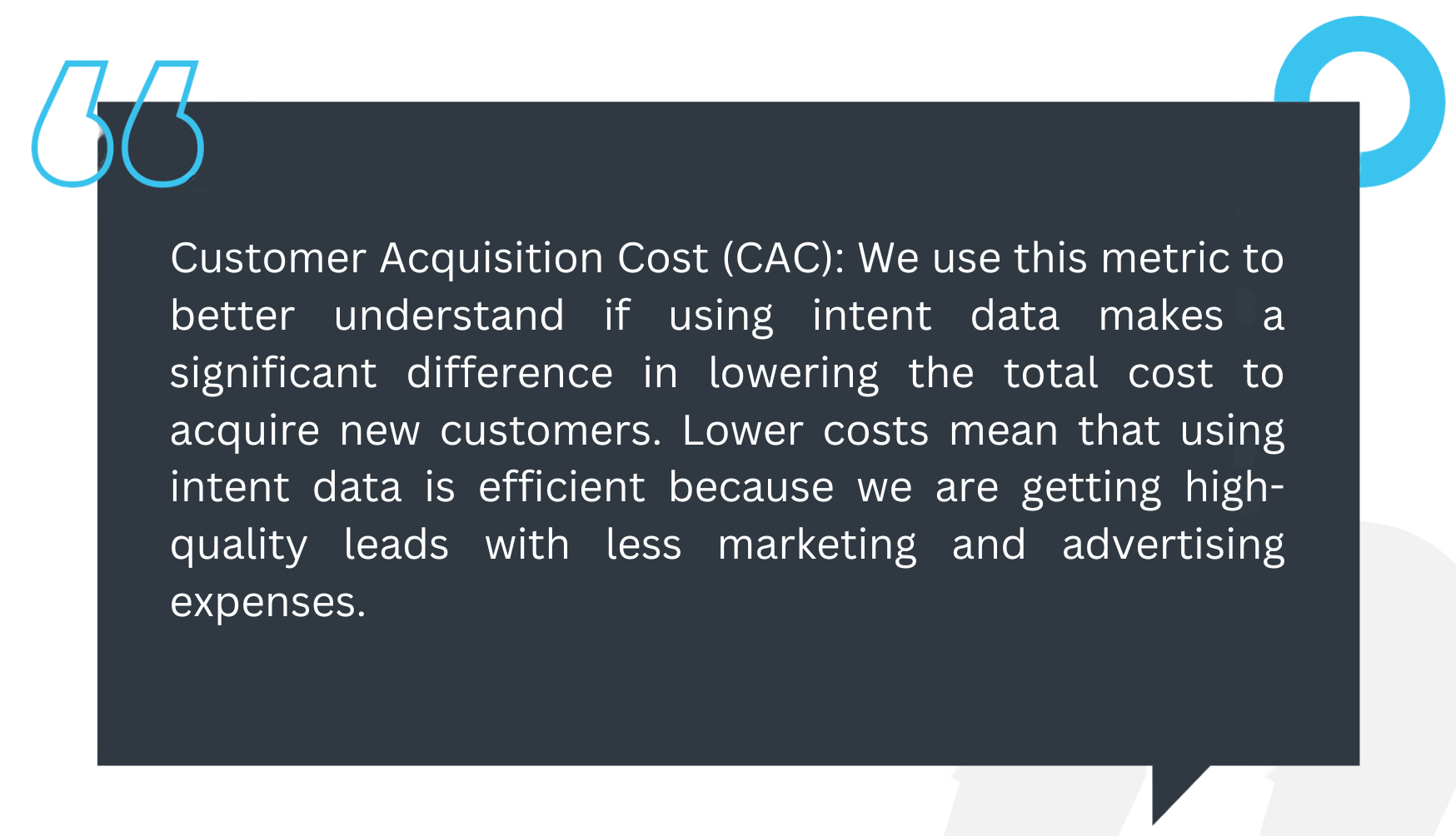
Mia Tayam
~2 min
13 Ways to Measure the Impact of Intent Data
Intent data use has undeniably become most businesses' "go-to" tool. Despite its widespread adoption, a clear and comprehensive understanding of its impact on businesses is still worth an overview.
Why gauge the impact of intent data?
Like any other tool or business approach, the real challenge lies in proving its contribution to the company's growth. How can it impact the pipeline and contribute to the organization's growth?
This will further help teams to justify why they should continuously adopt it in their efforts.
That is why we at N.Rich and Driving Demand conducted a State of Intent Data Study to gain insights into the unexplored areas of intent data, particularly how to demonstrate its impact when utilized. Fifty sales and marketing leaders were interviewed to gain a more detailed and practical insight into how they measure the effectiveness of their intent data initiatives.
If you want to ramp up your 2024 efforts, then this article is an ideal resource to guide you in measuring the impact of your intent data strategy. Alternatively, it can help you prepare your deck for buy-in if you consider integrating intent data to complement your future growth plans.
What are the ways to measure the impact of intent data?
Here are the top responses provided by our participants based on their approaches. This will allow you to dive deeper into the measurement of intent data impact through:
- Conversion Rate (32%)
- Influenced Pipelines/Opportunities (16%)
- ROI/ROAs (14%)
- SQLs (9%)
- New Meetings Booked (7%)
- Revenue and New Sales (5%)
- Sales Velocity, Deal Size, and Lead Quantity (4%)
- CAC, LTV/CLV, and Lead Quality (2%)
Conversion Rate
Based on the recent State of Intent Data Study we conducted, 32% of the respondents measure the impact of intent data through conversion rate. Most of our respondents rely on this metric for a tangible outcome. How many of your leads were pushed to the funnel because you have a better grasp of your customers' needs and what they are looking for?
 James Wilkinson, Co-Founder and CEO of Balance One Supplements, US
James Wilkinson, Co-Founder and CEO of Balance One Supplements, US
Influenced Pipelines/ Opportunities
While 16% of the respondents measure the impact of intent data through influenced pipelines/opportunities -- Knowing customers' intent will help you get an express ticket from the awareness or consideration stage to an accelerated buying mode.
 Joe Kevens, Director of Demand Generation, PartnerStack
Joe Kevens, Director of Demand Generation, PartnerStack
Return of Investment/ Return on Ad Spend
The other 14% of the respondents measure the impact of intent data through ROI/ROAS. This metric delves into the financial performance of campaigns driven by intent data, providing a clear understanding of the monetary outcomes associated with these efforts.
 Ryan Steinolfson, Founder, Accelerate Marketing
Ryan Steinolfson, Founder, Accelerate Marketing
Sales Qualified Leads
The fourth highest response we received was at 9%, measuring the impact of intent data on SQLs and opportunities. Did considering customer intent improve lead quality? Are you still capturing the wrong leads who are not interested in the solution or service you offer or are not ready to purchase?
 Casey Preston, Enterprise Account Executive, Experience.com
Casey Preston, Enterprise Account Executive, Experience.com
Booked Meetings
The other 7% of respondents consider the number of new meetings booked as a metric to assess the influence of intent data on their business. They see this as a concrete indication of securing new engagements to drive meaningful interactions and create opportunities based on their intent level.
 Murray Vince, General Counsel & VP Business Development, Mosquitech
Murray Vince, General Counsel & VP Business Development, Mosquitech
Revenue and New Sales
At a shared 5%, our respondents measure intent data impact with revenue and new sales. They emphasize a direct link between the impact of intent data and measurable financial outcomes---tracking both revenue growth and the acquisition of new customers as key indicators of the effectiveness of intent-driven strategies.
 Peter Mollins, CMO, SetSail
Peter Mollins, CMO, SetSail
Sales Velocity, Deal Size, and Lead Quantity
On the other hand, three factors share the 4% mark: respondents weigh sales velocity, deal size, and lead quantity when assessing the impact of an intent data strategy on their business. This reflects a comprehensive perspective, offering a holistic evaluation that spans from the volume of leads influenced by intent data to the speed of sales and the subsequent impact on deal sizes.
a5f7.png) Thomas Giarraputo, Vice President, Executive Cleaning Services
Thomas Giarraputo, Vice President, Executive Cleaning Services
Customer Acquisition Cost, Customer Lifetime Value, and Lead Quality
Despite a low representation at 2%, like our respondents, it's important to consider factors such as CAC, LTV/CLV, and lead quality when evaluating the impact of your intent data efforts. These metrics offer valuable insights into the resource investment versus sales outcomes, providing a better understanding of the efficiency and sustainability of your intent-driven strategies.
 Hafsa Unnar, Executive Assistant, On-Site First Aid Training
Hafsa Unnar, Executive Assistant, On-Site First Aid Training
 Sam Tabak, Co-Founder, Rabbi Meir Baal Haness Charities
Sam Tabak, Co-Founder, Rabbi Meir Baal Haness Charities
Recap
The important objective remains consistent: pinpoint how intent data directly or indirectly influences your growth goal efforts.
While your chosen metric might differ or be a mix of the above-mentioned factors, the ultimate goal is to properly utilize it and demonstrate the effectiveness of intent data in enhancing outcomes. Justifying the continued reliance on this data involves showcasing its significant impact, and regardless of the measurement approach, the ultimate validation lies in the bottom-line numbers.
Besides the metrics to quantify the business impact of intent data, the study by N.Rich and Driving Demand also touches upon:
▪︎ Top use cases for intent data
▪︎ Insights into the buying process of intent data tools
▪︎ Main concerns regarding the use of intent data
Get your full and ungated State of Intent Data Study copy here.
